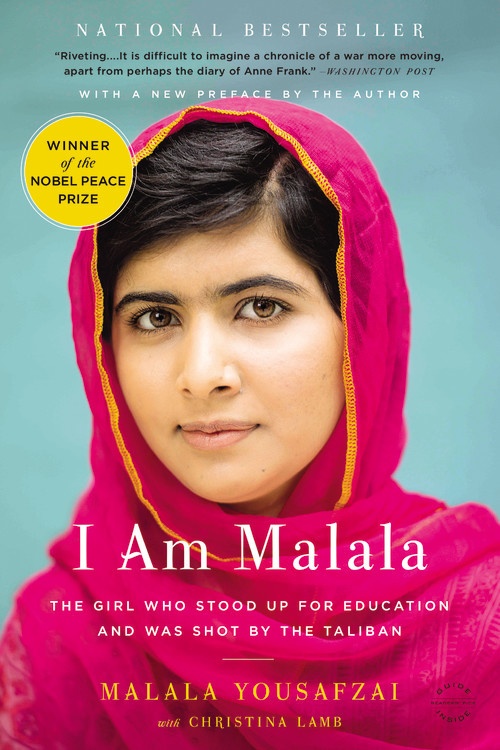Malala Yousafzai begins her story in I Am Malala by recounting the day she was shot on her way home from school in Pakistan’s Swat Valley. She was fifteen years old. This traumatic experience was what made Malala a household name all over the world. No doubt, she’s recounted this day hundreds of times, to the press, to politicians. The global fascination with the violence bestowed on her all because she refused to give up her right to an education is now a part of her life forever. That terrible shooting has given her a platform for her life’s work: furthering unfettered access to an education for all women.
Placing the details of the shooting in the prologue gives her memoir great momentum and makes a point: that event does not define Malala. It’s the rest of the story that gives insight into her character. Malala became an international symbol of peace on October 9, 2012, and went on in 2014 to become the youngest person ever, at age seventeen, to win the Nobel Peace Prize. But she is not only a symbol, she is also a girl.
Malala grew up in a Pashtun family with her mother, father, and two brothers near Mingora, the main city of Swat. Her father, Ziauddin Yousafzai, instilled the importance of education in her at an early age, and she loved school. Ziauddin founded the Khushal School three years before Malala was born. Malala grew up surrounded by its students and teachers. By the time she was in second grade, the school had eight hundred students and three divisions—an elementary school and two high schools, one for boys and one for girls. Ziauddin believes that education is the right of all children, regardless of gender or economic class. Malala became passionate about her father’s work, and soon the two of them were a team, traveling and speaking with politicians about the importance of providing easy access to schools for all children.
But as the Taliban’s influence increased in the Swat Valley, it became more and more dangerous for Malala and her family. Both she and her father were well known in the community for speaking to local politicians and making public speeches in favor of girls’ education, directly defying Taliban radio broadcasts proclaiming that it is sinful for women to go to school. Friends started to warn them that they were drawing too much attention to themselves and suggested they stop speaking out for their own safety, but Malala would not be silenced.
When the violence between the local military and the Taliban made life unsafe for everyone, she and her family had to leave their home as refugees and stay with relatives near Swat. When they returned, it was to find a home battered by constant fighting, but they had hope that this time they were back for good. The narrative builds back up to the fateful day of the shooting, and pushes forward into the aftermath and all that it implied: fame, scrutiny, and emigrating from Pakistan.
Malala’s prose gives voice to one of the least-heard perspectives in international media, a young woman of color in a war-torn country. She gives context to the political and military realities of living in contemporary Pakistan by sharing a glimpse into her everyday life—the normal, the terrifying, and everything in between. Co-author Christina Lamb also lent her expertise as a foreign correspondent, giving the book the well-researched feel of cutting-edge journalism while Malala’s unique diction keeps this story chiefly a human one.
I Am Malala is an important book because news about conflict in the Middle East has become so pervasive that we can keep it at arm’s length, emotionally. But while we have the luxury of changing the channel or turning off the nightly news, hearing the story of one girl who knows that violence intimately, who writes about how drone strikes affect her and the people she loves, gives a face to the explosions that are so tragically commonplace on TV. Malala’s story has the potential to motivate people to sit up, pay attention, and make a difference—just as one courageous Pashtun girl did before and after October 9, 2012.
Helen Seachrist is a story lover and an associate production editor at Houghton Mifflin Harcourt.








